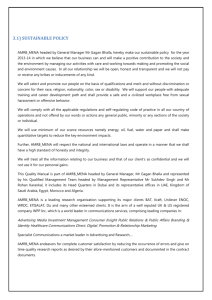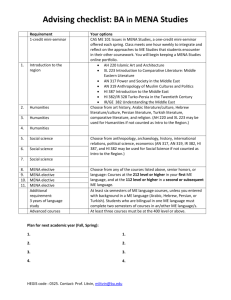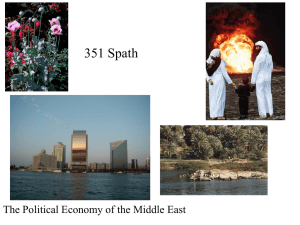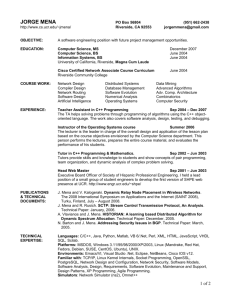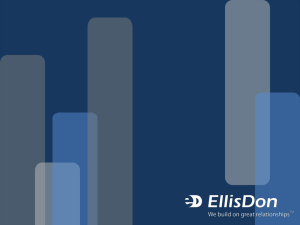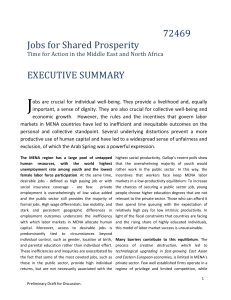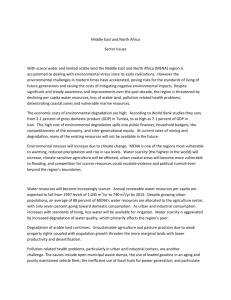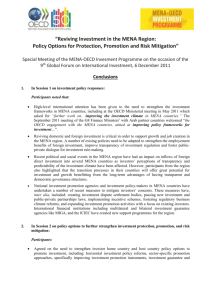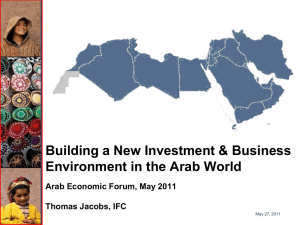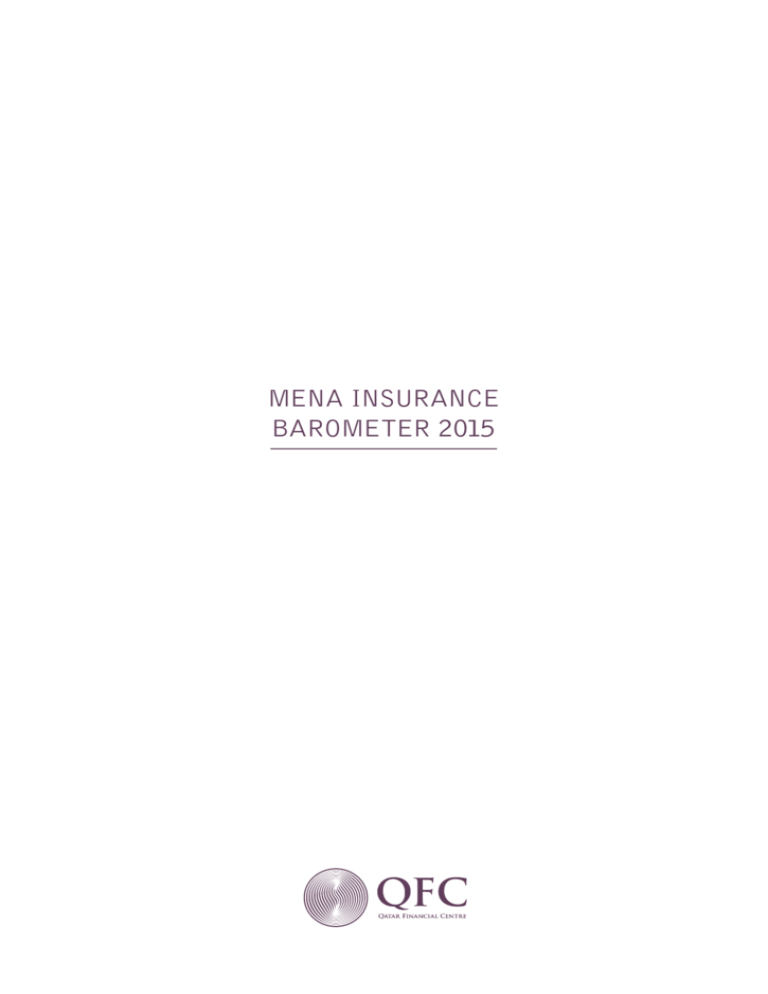
MENA INSURANCE
BAROMETER 2015
MENA INSURANCE BAROMETER
No 3 / March 2015
For further information about the report, please contact:
YOUSEF FAKHROO
Director of Marketing and Corporate Communications
Qatar Financial Centre Authority (QFC Authority)
Telephone: +974 4496 7784
Fax:
+974 4496 7669
Email:y.fakhroo@qfc.qa
To download a soft copy of the report, please visit www.qfc.qa
© Qatar Financial Centre Authority 2015.
All rights reserved. No part of this publication may be reproduced, stored in a retrieval system, or transmitted in any form or by any means, electronic
or otherwise without the prior permission of the copyright holder. The MENA Insurance Barometer is published annually by the Qatar Financial Centre
Authority (QFCA). While the QFCA makes all reasonable efforts to ensure that the information contained in the report (information) is accurate, complete
and not misleading, no warranty, representation or undertaking of any kind whatsoever is given by the QFCA. The QFCA and its representatives shall not be
liable, directly, indirectly or howsoever for any loss of damage suffered or incurred by any party using or relying upon the information. Further, no liability
whatsoever is accepted for any errors, omissions or statements contained in the information. Accordingly, all third parties accessing, using and/or relying upon
the information expressly undertake to carry out their own due diligence and independent verification of the accuracy and completeness of the information.
CONTENTS
FOREWORD BY THE CHIEF EXECUTIVE OFFICER
AND BOARD MEMBER OF THE QATAR FINANCIAL
CENTRE AUTHORITY (QFC AUTHORITY)
5
METHODOLOGY
6
SUMMARY OF KEY FINDINGS
7
KEY BAROMETER READINGS
8
MARKET OVERVIEW
9
SURVEY RESULTS
16
• The overall perspective:
Strengths, weaknesses, opportunities and threats
• General insurance market status and outlook
• Lines of business-specific prospects
• Key market trends and drivers
FOREWORD
SHASHANK SRIVASTAVA
Chief Executive Officer and Board Member of the Qatar Financial
Centre Authority (QFC Authority)
We are pleased to present the third edition of the annual MENA
Insurance Barometer. The Barometer is based on in-depth
interviews with senior executives of 37 regional and international
insurance and reinsurance companies, as well as intermediaries
operating in the region. For the third consecutive year, it provides
an overview of the current state and near-term prospects of the
US$ 50 billion insurance markets comprising the Middle East
and North Africa (MENA) with a total population of close to
380 million and a combined gross domestic product (GDP) of more
than US$ 3.7 trillion. As in the past, the Barometer also offers a
summary of key regional insurance market data.
The most recent survey reveals the robust and resilient
attractiveness of the region’s insurance markets, even in the face
of economic headwinds. Confidence among survey participants has
been strengthened by stabilising, and, partially increasing rates, in
personal lines business in particular. In addition, the fundamentals
remain promising: insurance penetration is on the rise as premiums
continue to grow faster than GDP, demographics are favourable,
and the ability of most Gulf countries to withstand short-term
volatility in oil prices is strong. At the same time, political stability
in Northern Africa is improving whilst the mayhem in Syria and
Iraq continues.
Through the Barometer, the QFC Authority demonstrates its
commitment to fostering greater transparency in the MENA
insurance marketplace and providing market participants with an
additional benchmark for decision-making. After three years, we
are also starting to see the benefits from tracking and analysing
market sentiment over time, based on a consistent methodology.
We hope you will enjoy reading this report and benefit from the
findings of our third MENA Insurance Barometer. Please do share
any feedback on the report as well as thoughts on how we can
collectively advance the concept of insurance in the Middle East.
5
METHODOLOGY
The findings of this report are based on in-depth and structured telephone or
face-to-face interviews with executives representing 37 regional and international
(re)insurance companies and intermediaries. The interviews were conducted
by Dr Schanz, Alms & Company AG, a Zurich-based research, strategy and
communications consultancy, in December 2014 and January 2015.
The companies that took part in the survey were:
• Africa Retakaful, Egypt
• Misr Insurance Company, Egypt
• Alkhaleej Takaful Group, Qatar
• Munich Health, UAE
• Allianz Global Corporate & Specialty, UAE
• Munich Re, Germany
• Al Wathba National Insurance Company, UAE • National General Insurance Company, UAE
• American International Group (AIG), UAE
• National Health Insurance Company, Qatar
• Arab Insurance Group (Arig), Bahrain
• Orient Insurance Group, UAE
• Arab Re, Lebanon
•Q
atar General Insurance & Reinsurance
Company, Qatar
• Arope Insurance, Lebanon
• Qatar Insurance Company, Qatar
• Asia Capital Re, UAE
• PartnerRe, Switzerland
• Bahrain Kuwait Insurance Company /
Gulf Insurance Group, Bahrain
• Chedid Re, Lebanon
• SCOR SE, France
•S
EIB Insurance & Reinsurance
Company, Qatar
• Emirates Insurance Association, UAE
• Solidarity Group, Bahrain
• Emirates Insurance Company, UAE
• Swiss Re, Switzerland
• Generali Middle East, UAE
• Takaful International Company, Bahrain
• Hannover Re, Bahrain
• Tawuniya, Saudi Arabia
• Jordan Insurance Company, Jordan
• Tokio Marine, UAE
• Marsh MENA, UAE
• MIG Holding, Bahrain
•U
nited Insurance Company, UAE
(former General Manager)
• Milli Re, Turkey
• XL Insurance, Switzerland
6
SUMMARY OF KEY
FINDINGS
1 Confidence in the future of the MENA insurance markets remains strong, despite ultracompetitive global and regional insurance markets and economic headwinds from falling oil
prices. 70% of executives polled expect regional premiums to outgrow GDP, only slightly
down from 76% a year ago. Survey participants are particularly bullish about personal
lines business which, in addition to compulsory insurance requirements, benefits from
regulatory action. Over the next 12 months, sliding oil prices are not expected to have any
material adverse impact on infrastructure and construction projects in the Gulf. Insurance
prospects for North Africa have improved on the back of a political stabilisation in
Egypt and Tunisia.
2 Participants continue to consider the region’s strong economic and direct insurance market
growth as its most important current strength, followed by a massive pipeline of major
infrastructure and construction projects and the region’s relatively moderate natural
catastrophe exposure.
3 Personal lines are viewed as the key future opportunity of MENA insurance markets, due
to population growth, legislation and partially improving rates. The prospect of additional
major infrastructure and construction projects in the Gulf region ranks second. Low
penetration levels are the third most frequently mentioned opportunity. For the wider
MENA region, the average share of premiums (non-life and life) in regional GDP is about
1.3%, compared with 6.5% for the world as a whole.
4 The Barometer found that 86% and 34% of executives polled view current prices in MENA
commercial and personal lines business, respectively, as being below the average of the past
five years, virtually unchanged from 2014. 81% and 89%, respectively, expect commercial
and personal lines rates to remain stable or improve over the next 12 months, very similar
to last year. However, in commercial and personal lines the share of those expecting rate
increases has grown from 19% to 30% and 21% to 37%, respectively. Rate expectations
remain moderately positive as prices appear to have hit bottom and regulators continue to
take supportive action.
5 Only 19% of respondents anticipate MENA insurance markets to consolidate over the
next 12 months, compared with 16% a year ago. Solid levels of capitalisation and family
ownership are major obstacles to consolidation. Regulators are widely viewed as the only
likely catalyst for consolidation over the longer run.
6 Only 32% of executives interviewed expect that foreign insurers will gain market share
over the next 12 months, marginally down from a year ago. Foreign insurers increasingly
prioritise profitability over growth. In addition, local competitors are stepping up
their game.
7 Only 21% of participants expect Takaful insurance to outgrow total insurance premiums
in the next 12 months, similar to the findings of the 2014 Barometer. However, the share
of those predicting an underperformance of the segment has decreased from 32%
to 22%. This slightly more favourable overall assessment of the prospects of Takaful
reflects the more upbeat outlook for personal lines where Takaful companies can most
effectively compete.
7
KEY BAROMETER
READINGS
The Barometer measures current perceptions of the insurance market in the MENA
region, tracking them over time to monitor changes in attitudes. When comparing
2015 with 2014, the main differences in findings include:
• A somewhat less bullish view on insurance premium growth outperforming
GDP growth.
• A higher share of executives expecting rates and profitability to improve, in particular
for personal lines.
•
Remaining low expectations of industry consolidation and the degree of
foreign competition.
• A lower share of interviewees expecting Takaful insurance to underperform the
market as a whole.
Jan JanJan
Key readings ( in % of respondents agreeing ) 2013 20142015
Insurance premiums to grow faster than GDP*
68 7670
Insurance prices are currently low**
• Commercial lines
91
84
86
• Personal lines
55
36
34
Insurance prices to remain stable or increase*
• Commercial lines
77 8481
• Personal lines
72 9189
Insurance profitability is currently low**
• Commercial lines
666281
• Personal lines
39 3023
Insurance profitability to remain stable or improve*
• Commercial lines
77 8484
• Personal lines
83 8589
Insurance markets to consolidate*
36
16
19
Foreign market share to increase*
50
35
32
Takaful insurance to outgrow total market*
38 2221
*Over the next 12 months
**Compared with five-year average
8
MARKET OVERVIEW
9
ROBUST MENA GDP GROWTH
10.8
This report covers 14 countries in the Middle East and North Africa: Algeria,
Bahrain, Egypt, Iran, Jordan, Kuwait, Lebanon, Morocco, Oman, Qatar, Saudi
Arabia, Tunisia, Turkey and the United Arab Emirates. The country selection
(hereafter referred to as MENA) reflects the availability of internationally
comparable insurance data.
In 2013, these 14 countries, with a total population of close to 380 million,
generated a combined GDP of about US$ 3.7 trillion, more than 5% of the
world’s total. As an economic block the region would rank as the world’s
fourth-largest economy, ahead of Germany.
At an inflation-adjusted growth rate of 4.1% per annum between 2008 and
2013, the region’s economies grew markedly faster than the global average
(3.2%). Based on a buoyant non-hydrocarbon sector, Qatar is expected to
remain the region’s most vibrant economy, even after the completion of its
massive liquid natural gas development programmes. Going forward, the
region’s growth is forecast to only slightly exceed the world economy’s
performance (see chart 1).
6.6
CHART 1: R eal GDP growth (2008 – 2019f, annual averages, in %)
5.5
4.5
2008 – 2013
2014 – 2019 ( ESTIMATES, FORECASTS )*
4.4
4.1 4.1
3.9
3.9
3.7 3.5
3.2
3.2
2.2
2.2
0.8
QATAR
EGYPT
UAE
IRAN
KSA
TURKEY
MENA
WORLD
SOURCE: IMF, World Economic Outlook (October 2014)
*Forecasts do not fully incorporate the further fall in oil prices towards the end of 2014.
MARKET OVERVIEW 10
SLOWING GROWTH IN
OIL-EXPORTING COUNTRIES
The near-term economic outlook for the MENA region continues to reflect
the diversity across the region. The high-income oil exporting countries
still record robust growth, on the back of solid fiscal positions and
improving economic fundamentals (for example, a higher GDP share of the
non-hydrocarbon sector). However, fiscal positions in most oil exporters
are weakening, reflective of sharply declining oil prices in the second half of
2014 and continued high government spending. Medium term, measures to
strengthen fiscal positions are expected to slow economic growth, also in a
number of Gulf Cooperation Council (GCC) countries.
Deep-rooted socio-political tensions continue to weigh on the prospects
of some of the region’s countries. The humanitarian and economic
consequences are particularly severe in Iraq, Libya and Syria. However, a
number of countries, such as Egypt, Morocco and Tunisia, have embarked
on structural reforms, starting with an overhaul of inefficient and entrenched
subsidy schemes which have led to structural budget deficits.
MENA INSURANCE PENETRATION
ON THE RISE
Income per capita levels in the MENA region as a whole are similar to the
global average. The region’s insurance penetration levels, however, remain
extraordinarily low. In 2013 insurance premiums accounted for just 1.3%
of GDP, a fifth of the global average. Encouragingly, this gap is narrowing
as MENA insurance markets outpace regional GDP growth. Between
2008 and 2013, total non-life and life insurance premium volumes in the
region expanded from about US$ 30 billion to more than US$ 50 billion
(see chart 2). Going forward, this trend is expected to continue. Swiss
Re (Global Insurance Review 2014 and Outlook 2015/16) forecasts real
annual premium growth of about 5.5% for 2015 to 2016, higher than the
International Monetary Fund’s economic growth forecast for the region.
At a share of less than 16%, life business continues to play a relatively minor
role (in comparison with its global share of 56%).
CHART 2: M ENA insurance premiums by type (2008 – 2013, non-life versus life, in US$ billion)
NON-LIFE
LIFE
40.7
42.5
35.0
29.9
26.0
26.8
4.7
5.1
5.5
6.6
7.3
7.8
2008
2009
2010
2011
2012
2013
SOURCE: Swiss Re, sigma (January 2015)
MARKET OVERVIEW 11
14.2
CHART 3: Non-life real premium growth (2008 – 2013, annual averages, in %)
8.3
8.0
7.2
5.7
5.6
1.5
KSA
UAE
MENA
IRAN
MOROCCO
TURKEY
WORLD
SOURCE: Swiss Re, sigma (January 2015)
21.5
CHART 4: Life real premium growth (2008 – 2013, annual averages, in %)
18.6
11.8
8.2
7.3
2.2
-1.0
IRAN
KSA
SOURCE: Swiss Re, sigma (January 2015)
UAE
MENA
TURKEY
MOROCCO
WORLD
CHART 5:Geographical split of MENA insurance premiums in 2013
%
IA 3
%
S8
OTHER
ER
ALG
LEB
AN
EGY ON 3
PT 4 %
%
QATAR
4%
TURKEY 25%
MOROCCO 6%
%
3
1
KSA
UAE 16%
IRAN 18%
SOURCE: Swiss Re, sigma (January 2015)
Chart 5 reveals that the region’s four largest insurance
markets – Turkey, Iran, UAE and Saudi Arabia – account
for almost three quarters of the total premium pot.
MARKET OVERVIEW 13
Chart 6 provides the lines of business split in 2012 for a number of
MENA non-life insurance markets. Motor is still the largest segment in
major markets such as Turkey, Iran, Morocco and Egypt. However, over
the past few years, personal accident and health insurance have been
the fastest-growing segments in Saudi Arabia and the UAE, and now
represent the biggest market segment in these two countries. The main
drivers behind this spectacular growth are legislation, in particular
compulsory insurance requirements and population growth.
MOTOR
PROPERTY
PA/HEALTH
MARINE/AVIATION/TRANSPORT
MISCELLANEOUS
12
4
15
CHART 6: Lines of business split, 2012, in %
8
10
4
24
6
22
20
4
24
12
20
18
53
17
6
56
10
10
30
15
60
13
49
10
18
7
47
33
TURKEY
IRAN
SOURCE: AXCO, National Supervisory Authorities
21
23
UAE
KSA
19
EGYPT
QATAR
MOROCCO
MARKET OVERVIEW 14
Chart 7 illustrates the supply side structure of the region’s insurance markets,
demonstrating the significant intra-regional differences in market structure,
ranging from highly concentrated markets such as Iran to relatively
fragmented environments such as Turkey. Reasons for the former include
powerful national champions with a strong record of market leadership,
whereas the latter are characterised by low barriers to entry.
CHART 7: N on-life insurance market share of Top 5 insurers, 2012, in %
75
74
73
71
61
60
51
IRAN
EGYPT
QATAR*
MOROCCO
KSA
UAE**
TURKEY
SOURCES: National insurance associations and supervisory authorities
*Own estimate
**Estimate of Top 7 market share according to AXCO
MARKET OVERVIEW 15
SURVEY RESULTS
THE OVERALL PERSPECTIVE:
STRENGTHS, WEAKNESSES,
OPPORTUNITIES AND THREATS OF
MENA INSURANCE MARKETS
16
CONTINUED CONFIDENCE DESPITE
GROWING ECONOMIC RISKS
GROWTH MOMENTUM CONTINUES
TO BE KEY STRENGTH
As in 2014, the vast majority of participants consider strong economic and
direct insurance market growth as the most important current strength of
the MENA insurance marketplace. The second most frequently mentioned
strength is continued government spending on major projects, followed
by a relatively moderate natural catastrophe exposure (in the Gulf region,
the Levant and Egypt) which still allows for technical profits despite
rock-bottom insurance rates (see chart 8).
he Saudi insurance market is benefiting from tighter and more effective regulations,
T
resilient economic conditions and strong demand for insurance as the population
keeps growing.
Raed bin Abdullah Al-Tamimi, CEO, Tawuniya
he ‘Arab Spring’ has improved people’s awareness of insurance and has led to a more
T
risk-conscious mentality.
Mohamed Khalifa, Vice Chairman, Misr Insurance Company
ven smaller domestic insurers increasingly look for opportunities abroad, in particular
E
in other GCC countries. This urge to expand geographically is driven by a search for
‘greener pastures’ and the accelerating economic integration throughout the region.
It adds to the need for harmonised regulatory frameworks as well as specific rules
governing cross-border trade in insurance services.
Yassir Albaharna, CEO, Arig
ahrain is a very well-regulated market place. Unfortunately, that is not true of all the
B
other markets in the region. As the economies of the region in general and the insurance
markets in particular are closely entwined, inconsistent regulation is a major obstacle to
further growth.
Sai Gopal, Chief Underwriting Officer, Bahrain Kuwait Insurance Company
SURVEY RESULTS: The overall perspective 18
CHART 8: M arket strengths (number of mentions)
GDP AND (RE)INSURANCE GROWTH MOMENTUM 26
GOVERNMENT SPENDING ON PROJECTS 16
LOW NATURAL CATASTROPHE EXPOSURE 8
UNHEALTHY COMPETITION STILL
VIEWED AS MAJOR WEAKNESS
As in the 2014 Barometer, poor levels of technical rates and profitability
as a consequence of fierce competition continue to be perceived as the
most relevant weakness of the MENA insurance marketplace. This result is
particularly true for the relatively easily accessible and mostly catastrophefree GCC countries. Regulatory shortcomings rank second. In 2014, they did
not feature among the three most important weaknesses. The same is true
for a generally low degree of awareness of insurance. Insurance still tends
to be bought only when required by compulsory schemes or banks as part
of a loan (see chart 9).
SURVEY RESULTS: The overall perspective 19
CHART 9: Market weaknesses (number of mentions)
UNDERPRICED BUSINESS 21
POOR REGULATIONS 15
LOW AWARENESS 14
T
he lack of consumer awareness and insurance insight is the biggest structural impediment
to Qatar and other MENA insurance markets reaching their full potential. There is a
very large consumer base that only acquires insurance for legal purposes. Insurers need
to make a collective effort to address this shortcoming, and educate the market. An
insurance policy should be considered as valuable support for personal and business
growth. It should not be seen as a purely legal requirement.
Jassim Ali A. Al-Moftah, Chief Executive Officer, Alkhaleej Takaful Group
In terms of their future premium growth, the MENA insurance markets will vary
largely – mainly due to the decline in oil price. For the oil-producing countries we expect
that next year’s premiums will only grow in line with GDP, while oil-importing economies
like Egypt will see its premiums grow in excess of GDP growth, due to its ambitious
development plans and because the low oil price will benefit consumption.
Omar Gouda, Managing Director, Africa Retakaful
T
he lack of local talent remains one of the most serious weaknesses of the region’s
insurance markets. For Boards of Directors and senior management teams it is now
the time to walk the talk and address the issue. This is of utmost importance in order to
ensure the sector’s long-term sustainable development.
James Portelli, Former General Manager, United Insurance Company
SURVEY RESULTS: The overall perspective 20
PERSONAL LINES BUSINESS
CONSIDERED AS MOST
IMPORTANT OPPORTUNITY
The prospect of additional and broader compulsory schemes coupled with
continued population growth ranks first among the future opportunities
and is expected to boost personal lines insurance business such as medical
and motor insurance. In second place, and down one position, is a strong
and resilient pipeline of major infrastructure and construction projects in
the Gulf region (driven by the Dubai World Expo 2020 and Qatar FIFA
2022), and, to a lesser extent, also in a stabilising and recovering Egypt.
Low penetration levels are the third most frequently mentioned opportunity.
The average share of premiums in the wider MENA region’s GDP is about
1.3%, compared with 6.5% for the world as a whole. As the MENA region’s
average GDP per capita is similar to the global average, the potential
penetration is a multiple of the current one (see chart 10).
CHART 10: M arket opportunities (number of mentions)
27
PERSONAL LINES
PROJECTS PIPELINE 13
LOW PENETRATION 11
SURVEY RESULTS: The overall perspective 21
T
he political stabilisation in Egypt and the subsequent improvement of the overall
business and investment climate offer plenty of opportunities, for example in
commercial lines such as construction.
Mohamed Khalifa, Vice Chairman, Misr Insurance Company
G
CC countries are making rapid progress in implementing their overarching
economic policy strategy to diversify away from the hydro-carbon sector. As a
result, a new risk landscape emerges. The rise of the manufacturing and services
sectors, for example, presents major new opportunities for insurers.
PE Alexander, CEO, Qatar Insurance Company
I n addition to personal lines we are seeing major opportunities in specialty business
such as professional liability. Growth prospects in this area are not only driven
by compulsory insurance requirements but also an increasing sophistication and
internationalization of policyholders.
Nagib Bahous, CEO, MIG Holding
espite significant competitive challenges, the MENA insurance markets offer
D
exciting opportunities. Low penetration levels suggest a vast untapped potential at
a multiple of today’s market size.
Mahomed Akoob, Managing Director, Hannover ReTakaful
SURVEY RESULTS: The overall perspective 22
ECONOMIC RISKS NOW TOP THE
LIST OF CHALLENGES
Most respondents consider economic risks as the most relevant challenge to their
operating environment, replacing political instability which now ranks second.
The dramatic fall in oil prices since the summer of 2014 is causing nervousness
among many respondents, not least because of adverse effects on the region’s
financial markets. In case of continued pressure on oil prices, some governments
may be forced to curtail their spending as from 2016, negatively impacting
commercial lines business in particular.
Despite the rise of IS and the continued civil war in Syria and Libya, political
risk is mentioned less frequently than in 2014. The prospect of Iran rejoining the
international community, the stabilisation in Egypt and the further consolidation
of Tunisia’s new political order are viewed very positively.
The third most frequently mentioned risk factor (as in 2014) is the potentially
destabilising effect of fierce competition, which a number of interviewees
continue to refer to as ‘irrational’. Concerns are compounded by the fact that
investment results in the region have become more volatile as a result of sliding
oil prices (see chart 11).
CHART 11: Market threats and challenges (number of mentions)
ECONOMIC RISKS 26
POLITICAL INSTABILITY 17
EXCESSIVE COMPETITION 9
any MENA insurers’ business models are coming to a difficult stage due to decreasing
M
enthusiasm and availability of attractive and suitable reinsurance, continued low interest
rates, pressure on asset values, losses and consequently an increasing pressure on their
net financial resilience.
Andreas Pollmann, Client Management Executive MENA, Munich Re
eturns from stock markets in the region have come under severe pressure recently. The
R
ultimate impact on insurance market behaviour is difficult to predict: Some insurers will
place more emphasis on underwriting profitability. Others will continue to rely on (even
more aggressive) cash-flow underwriting.
Dr Frank Mayer, Managing Director Reinsurance, Munich Re Underwriting Agents
(DIFC) Ltd (Munich Health), Region Middle East & Africa
M
ENA insurance markets are still characterised by a continued influx of capacity
from global and regional reinsurance markets. Excess capacity could jeopardise
the (partial) improvements achieved on treaty terms and conditions over the past
two years. Although competition is inevitable and here to stay, the reinsurers
operating in the region should at least be in a position to maintain these levels of
achievements. Everybody knows that current pricing levels will not allow for absorbing
a major loss.
Gökhan Aktas, Head of Foreign Inward Business, Milli Re
SURVEY RESULTS: The overall perspective 23
SURVEY RESULTS
GENERAL INSURANCE MARKET
STATUS AND OUTLOOK
SURVEY RESULTS: The overall perspective 24
GENERAL INSURANCE
MARKET STATUS AND OUTLOOK
RESILIENT GROWTH AND
MODERATELY IMPROVING PRICING
AND PROFITABILITY OUTLOOK
Low commercial insurance rates and average prices in personal lines
In line with 2014, the Barometer found that 86% of those interviewed
view current prices in MENA commercial lines business as being below the
average of the past five years. Competition remains fierce, reflecting the
continuing abundant supply of reinsurance and the increasing relevance of
brokers. Many interviewees consider current prices to be at an ‘all-time low’.
This is particularly true for the Gulf insurance markets which are highly
attractive, easily accessible and, in general, not prone to catastrophe losses.
Participants judge personal lines business more favourably, with 63%
saying that premium rates are at average levels, against 61% a year
ago. In comparison with commercial insurance, personal lines business
is characterised by a smaller number of players, higher barriers to entry,
greater customer loyalty and, as a result, a better balance between demand
and supply, resulting in more room for upward rate adjustments. In addition,
non-price competition, for example through distribution or services, plays
a significant role. Furthermore, personal lines business tends to be more
adequately priced as it is largely retained by insurance companies who have
more ‘skin in the game’. Last but not least, in the most recent past, medical
and motor rates have benefited from regulatory intervention, with the Saudi
Arabian Monetary Agency (SAMA), for example, mandating the use of
independent pricing and reserving actuaries (see charts 12 and 13).
he current state of the market reflects a prolonged soft cycle. However, in the industry’s
T
own interest, this must not give rise to unbridled and self-defeating competition.
Mahomed Akoob, Managing Director, Hannover ReTakaful
ne of the advantages of the GCC insurance market is its growth potential. However, it is
O
also a non-CAT market. This means there is no natural limit to the current rate decline as
there is no CAT event in sight which would possibly turn the market. In fact, rates may
continue to fall.
Rainer Lehner, Senior Executive Officer, Asia Capital Re
n the regulatory front, we are seeing positive and encouraging signs, with some
O
authorities enforcing more stringent rules on rates, reserves and solvency. However,
much remains to be done in order to establish a homogenous regulatory environment
with ‘passporting’ opportunities for the region’s insurance companies.
Farid Chedid, CEO, SEIB Insurance & Reinsurance Company
SURVEY RESULTS: General insurance market outlook 26
HIGH
3%
CHART 12: Current level of rates – Commercial lines
AVERAGE
11%
LOW
86%
HIGH
3%
CHART 13: Current level of personal lines
LOW
34%
AVERAGE
63%
SURVEY RESULTS: General insurance market outlook 27
IMPROVING PRICING OUTLOOK,
IN PARTICULAR IN PERSONAL LINES
Roughly half of the respondents expect rates to remain flat over the next
12 months. The share of those expecting higher rates in both commercial
and personal lines has increased, from 24% and 27%, to 30% and
37%, respectively.
Most interviewees believe that rates have hit bottom. Reinsurers are less
accommodating following a series of major commercial lines losses. The
markedly more positive assessment of personal lines pricing prospects
reflects the full effect of SAMA’s regulatory ‘crack-down’ which started in
2013 and saw the appointment of independent external auditors to enforce
more rigorous pricing and reserving practices. A number of executives
polled expect positive knock-on effects on other (GCC) countries, too
(see charts 14 and 15).
MODERATELY
LOWER
19%
MODERATELY
HIGHER
30%
STABLE
51%
CHART 14: Pricing outlook – Commercial lines
MODERATELY
LOWER
11%
MODERATELY
HIGHER
37%
CHART 15: Pricing outlook – Personal lines
STABLE
52%
SURVEY RESULTS: General insurance market outlook 28
he current downturn in investment results could inject more technical discipline in the
T
market place. The larger, strongly branded insurers in particular are expected to push for
higher rates and more rigorous terms and conditions.
Farid Chedid, Chairman & CEO, Chedid Re
rom our perspective, prices are stabilising. In particular, the regulatory interventions of
F
SAMA in Saudi Arabia including its introduction of more stringent capital requirements
and more justifiable rating mechanisms in compulsory lines are positively impacting
insurance rates. We expect that the regulator’s action will have a lasting effect for at
least the next 12 months.
Keith M. Byrne, Director, General Insurance Operation,
Tokio Marine Middle East Limited
T
here are huge differences in sophistication of regulatory frameworks across
the Middle East: In some markets, regulations are still relatively weak. In other
jurisdictions we are seeing signs of overregulation with regulators starting to impose
strict rules on rates, loadings, etc.
Dr Frank Mayer, Managing Director Reinsurance,
Munich Re Underwriting Agents (DIFC) Ltd (Munich Health),
Region Middle East & Africa
PROFITABILITY WEIGHED DOWN BY LOW
RATES AND INCREASING LOSSES
The survey found that 81% of respondents consider overall profitability in
commercial lines to be low (benchmarked against the past five years), up
from 62% last year. This assessment is primarily a result of a further erosion
of rates over the past 12 months in combination with a higher frequency of
relatively large (fire) losses. In addition, strong investment returns in 2014
have encouraged some underwriting largesse. The non-Gulf markets are
considered more profitable because of more advanced regulatory and risk
management frameworks, despite a higher exposure to natural disasters.
Personal lines business continues to be viewed more favourably, also in
comparision with last year’s Barometer. 77% of executives polled describe
profitability as average, up from 67% in 2014. The effect of regulatory
tightening started to make itself felt in 2014, raising the five-year average of
profitability (see charts 16 and 17).
SURVEY RESULTS: General insurance market outlook 29
CHART 16: Current level of profitability – Commercial lines
AVERAGE
19%
LOW
81%
LOW
23%
CHART 17: Current level of profitability – Personal lines
AVERAGE
77%
ommercial lines business in the region is expected to remain highly competitive, given the
C
glut in global reinsurance capacity and the absence of any significant market losses.
Ashraf Bseisu, Group Chief Executive Officer, Solidarity Group
The MENA insurance industry will move back to underwriting basics once new regulations
aimed at adequate reserving have been implemented and enforced.
Basma Barakat, Assistant General Manager, Arab Re
audi Arabia is one of the few markets where we expect commercial lines rates to
S
moderately recover, driven by improved regulatory oversight and risk management
practices as well as less accommodating reinsurers.
Salvatore Orlando, Head of High Growth Markets, PartnerRe
SURVEY RESULTS: General insurance market outlook 30
IMPROVING OUTLOOK FOR PERSONAL
LINES PROFITABILITY
The majority of participants expect profitability in commercial lines to remain
unchanged over the next 12 months. 24% of executives polled, up from 19%
in 2014, believe that profitability will moderately improve. On the one hand,
ample (reinsurance) capacity continues to weigh on margins. On the other
hand, investment income is expected to come under pressure. This trend could
encourage commercial lines insurers to place more emphasis on underwriting
profitability. The net effect from these conflicting forces is uncertain.
Profitability expectations in personal lines have improved more noticeably over
the past 12 months (with the share of those anticipating increased profitability
almost doubling), largely attributable to regulatory measures in Saudi Arabia.
Initially, these measures put pressure on profitability as medical and motor
insurers were required to increase technical reserves. In the meantime, the
positive effect from higher technical rates is starting to filter through. In
addition, the ‘back-to-technical basics’ effect from eroding investment returns
is even stronger in personal lines business which is largely retained by insurers.
Having said this, social inflation, for example in the provision of health care
services, remains a severe concern and a number of interviewees question
whether the most recent rate increases will be sufficient to offset this adverse
inflationary impact (see charts 18 and 19).
CHART 18: O utlook profitability – Commercial lines
MODERATELY
HIGHER
24%
MODERATELY
LOWER
16%
STABLE
60%
SURVEY RESULTS: General insurance market outlook 31
he Gulf region in particular has seen significant improvements in terms of the quality
T
of available capacity, the maturity of risk takers and advisors and the proximity to
underwriting decision-makers. These developments have added to the market’s strength
and resilience.
Robert Makhoul, Executive Chairman, Marsh MENA
he insurance markets in which we operate – the Levant, in particular Jordan, and the
T
Gulf – are highly professional and well advanced. Apart from a few exceptions all players
in the region are rated. The markets are closely regulated and, in addition, our personnel
are well trained and skilled. Finally, the IT systems we use are state-of-the-art and provide
us with full transparency by the minute.
Imad Abdel Khaleq, CEO, Jordan Insurance Company
ersonal lines probably offer the biggest potential for insurance in the region. On the
P
one hand, their growth is fuelled by compulsory insurance requirements. On the other,
awareness is improving as insurers introduce and market new products.
Khalid Al Mughesib, Advisor at the Office of HE, the Minister of Finance of the State
of Qatar and Vice Chairman of the National Health Insurance Company
CHART 19: Outlook profitability – Personal lines
MODERATELY
HIGHER
40%
STABLE
49%
MODERATELY
LOWER
11%
SURVEY RESULTS: General insurance market outlook 32
INSURANCE PENETRATION
EXPECTED TO INCREASE
Over the next 12 months, 70% of the survey respondents expect insurance
premiums in the MENA region to grow at a faster pace than regional GDP,
down from 76% in 2014. This still bullish assessment reflects a strengthened
outlook for personal lines which are set to benefit from additional compulsory
insurance requirements, further rate increases as well as advances in distribution
(for example, bancassurance). In most GCC countries, in the short term, the vast
pipeline of major construction and infrastructure projects will not be adversely
affected by sliding oil prices and continues to underpin the anticipated increase
in insurance penetration. Survey participants were also optimistic about Turkey
(benefiting, for example, from a much improved regulatory environment) and
Northern Africa where political instability seems to be receding (see chart 20).
dequate solvency regulations would go a long way in strengthening market discipline and
A
enabling a more stable and sustainable growth path for the region’s insurance markets.
Bassam Chilmeran, General Manager, Al Wathba National Insurance Company
I nsurance penetration in the MENA region is expected to increase further. However, the
pace of premium growth is likely to slow given the macro-economic headwinds from
declining oil prices.
Dr Abdul Zahra Al Ali, CEO, National General Insurance Company
e welcome the changes to the regulatory environment for brokers. However, in
W
the interest of effective consumer protection, we urge regulators to maintain a level
playing field across the entire spectrum of distribution channels.
Robert Makhoul, Executive Chairman, Marsh MENA
SURVEY RESULTS: General insurance market outlook 33
CHART 20: Expected premium growth versus GDP growth
SLOWER THAN
GDP GROWTH
3%
IN LINE
WITH GDP GROWTH
27%
FASTER THAN
GDP GROWTH
70%
SURVEY RESULTS
LINES OF BUSINESS-SPECIFIC
PROSPECTS
36
LINES OF BUSINESS-SPECIFIC PROSPECTS
Over the next 12 months, medical insurance is expected to be the fastestgrowing line of business in the MENA region. Growth continues to be
fuelled by compulsory insurance requirements which, for example, have
made medical insurance the biggest line of business in Saudi Arabia.
New compulsory regimes are also being implemented in other jurisdictions
such as Qatar. In addition, in Saudi Arabia, medical insurance rates have
increased markedly as a result of regulatory intervention.
Motor business ranks second, driven by a combination of compulsory
insurance requirements and a continued population growth. Engineering
is the third most frequently mentioned line of business when it comes to
short-term growth prospects, reflecting major infrastructure and
construction projects in Saudi Arabia, the UAE, Qatar, and, to a lesser
extent, Egypt. Over the next 12 months, most interviewees do not expect any
negative implications of falling oil prices on project activity (see chart 21).
The ranking of these three lines of business is unchanged from the 2014
MENA Insurance Barometer.
CHART 21: The fastest-growing lines of business (number of mentions)
MEDICAL
22
MOTOR
ENGINEERING
29
17
SURVEY RESULTS: Lines of business-specific prospects 37
ompulsory business such as medical insurance will continue to be the fastest growing
C
segment of the market and is expected to further boost overall insurance penetration.
Maurizio Colautti, Deputy CEO Insurance, Qatar General
Insurance & Reinsurance Company
he introduction of new compulsory insurance requirements such as Medical Malpractice
T
and Lawyers Malpractice, is a major opportunity for liability insurers in the region.
Bassam Chilmeran, General Manager, Al Wathba National Insurance Company
he Middle Eastern insurance markets are changing rapidly. The most recent regulatory
T
and supervisory enhancements are set to further accelerate this transformation and
promote a more disciplined and sophisticated market place.
James Portelli, Former General Manager, United Insurance Company
As far as the slowest-growing lines are concerned, property business was
mentioned most frequently, mainly attributable to rock-bottom premium
rates. Marine hull insurance ranks second, reflecting the lower importance
of international trade as an engine of regional economic growth and the
absence of large commercial fleets. Liability insurance is the third most
frequently mentioned line as awareness remains low, despite an increasing
frequency of court rulings and a trend towards compulsory schemes in
professional liability (see chart 22). The overall ranking of lines has not
changed compared with the 2014 Insurance Barometer.
here is an urgent need for closer collaboration between legislators and insurance
T
regulators in order to ensure that courts rule according to applicable insurance regulations.
The current ‘disconnect’ is a major problem for insurers.
Basma Barakat, Assistant General Manager, Arab Re
Insurance companies which are highly trusted by their customers have best chances
to withstand the current soft market trends and to enjoy smooth performance and
solid growth. Long-term partnerships and business retention can be achieved only by
understanding customers’ needs, providing added value and risk management expertise in
order to actively protect the customers, their lives and their businesses.
Guido Zagatti, Senior Manager, Assicurazioni Generali S.p.A.,
Middle East Regional Office
he rapidly growing SME sector in the MENA region is one of the key opportunities
T
for the insurance industry to tap into. Typically these firms are run by the younger, more
entrepreneurial-minded generation, which has a different attitude towards insurance than
their established counterparts as they are keen to protect their newly created assets.
Sanjeev Badyal, CEO, Allianz Global & Corporate Specialty Dubai
SURVEY RESULTS: Lines of business-specific prospects 38
CHART 22: The slowest-growing lines of business (number of mentions)
PROPERTY MARINE HULL 17
LIABILITY 11
21
Over the next 12 months the survey respondents consider engineering as the
most profitable line of business, reflecting relatively high barriers to entry
and generally high standards of construction. Marine cargo was considered
the next profitable line of business, due to a relatively small number of
providers and low loss ratios. Life insurance was identified as the third most
profitable line. Group life insurance in particular is an attractive market
segment for insurers who are able to offer bespoke and value-added solutions
for corporate clients (see chart 23). Whilst the ranking for engineering and
marine cargo business did not change over the course of the past 12 months,
life insurance made it into the ‘Top 3’ for the very first time.
iven the strong pipeline of major construction and infrastructure projects as well as
G
additional compulsory insurance requirements, premium growth is poised to outperform
GDP growth over the foreseeable future.
Younis Jamal, CEO Takaful International Company
We are observing increases in property rates, as a result of large and frequent losses in
2014 and, given the fact that rates had reached their technical minimum.
Lukas Müller, Head Market Underwriter Africa & Middle East, Swiss Re
any insureds in the MENA region continue to benefit from natural catastrophe
M
cover which is given away free of charge. For some insurers this practice amounts to
brinkmanship, leaving them highly vulnerable to a major disaster.
Dr Chérif Chentir, Chief Underwriting Officer
Middle East & South Eastern Europe, SCOR SE
SURVEY RESULTS: Lines of business-specific prospects 39
CHART 23: The most profitable lines of business (number of mentions)
ENGINEERING 20
MARINE CARGO 16
LIFE
13
Property insurance is considered the least profitable area, up from third
rank in 2014. Competition has further intensified on the back of ample and
inexpensive reinsurance capacity. In addition, barriers to entry remain low in
this commoditised segment of the market. Motor and medical business rank
more favourably as compared with the 2014 MENA Insurance Barometer
as SAMA has proven how effective decisive regulatory measures can be in
strengthening the technical discipline of the marketplace. Rates in these two
areas of business have improved significantly and a number of interviewees
expect other regulators in the region to carefully study the Saudi example
(see chart 24).
CHART 24: The least profitable lines of business (number of mentions)
PROPERTY
MOTOR
MEDICAL
26
23
22
SURVEY RESULTS: Lines of business-specific prospects 40
SURVEY RESULTS
KEY MARKET TRENDS & DRIVERS
42
KEY MARKET TRENDS AND DRIVERS
INSURANCE REGULATIONS STILL
CONSIDERED INADEQUATE BUT IMPROVING
The Barometer found that 49% of respondents believe the overall state
of insurance regulation in the region to be inadequate, slightly down from
the previous survey. The most frequently mentioned shortcomings continue
to include a lack of solvency margins, not to mention risk-based solvency
rules, insufficient minimum capital requirements as well as a general lack of
cohesion, transparency, consultation and implementation.
However, most executives acknowledge that significant progress is being
made. In addition to and following the example of Saudi Arabia and
other countries, in particular UAE and Qatar, are committed to bringing
their respective regulatory environments in line with the requirements of
a modern insurance market. Furthermore, broker regulations are about to
be introduced, in the UAE, for example, which is viewed positively by most
interviewees given the increasing role of intermediaries and their perceived
contribution to price competition.
In general,the region is highly heterogeneous as far as regulatory sophistication
is concerned, ranging from relatively effective and sophisticated regimes in
Bahrain, Jordan, Morocco (coming close to Solvency II) and Saudi Arabia,
to rudimentary and/or insufficiently enforced frameworks in the Gulf region,
most notably Kuwait (see chart 25).
olvency and rating requirements have become an issue for very many MENA insurers
S
in most markets that cannot be resolved by the insurance companies alone – the
availability of solvency, capital management and rating expertise is becoming increasingly
relevant for MENA insurance companies to cope with the changing regulatory and
business environment.
Andreas Pollmann, Client Management Executive MENA, Munich Re
I expect major regulatory improvements in the UAE, such as the introduction of solvency
margins and specific regulations on reserving and investment policies.
Omer Hassan Elamin, President, Orient Insurance Group
I n the Middle East, insurance supervision tends to be more of a challenge than insurance
regulation. Many authorities simply lack the resources and specialist expertise to
effectively implement and enforce regulations.
Fareed Lutfi, Secretary General, Emirates Insurance Association
SURVEY RESULTS: Key market trends and drivers 43
CHART 25: State of insurance regulations
ADEQUATE
21%
MIXED
30%
INADEQUATE
49%
INSURERS REMAIN HIGHLY EXPOSED
TO NATURAL CATASTROPHE RISK
Executives views’ are evenly split as far as the adequacy of natural
catastrophe cover in the region is concerned. This outcome differs from last
year’s when 54% of participants felt that levels of natural catastrophe
protection, both in personal and commercial lines, are inadequate and only
46% opined that the exposure is adequately insured.
In this context it is important to differentiate between insurers and
insureds (such as households and corporations). Whereas the former are
not adequately covered through reinsurance protection (which now comes
with event limits), the latter benefit from cover, which, as a matter of fact, is
given away for free by many insurers. This is particularly true for the GCC
countries, but does not apply to highly exposed countries such as Turkey and
Algeria, where insureds are significantly more vulnerable to earthquake risk
than elsewhere in the region.
In many markets, the exposure to natural perils tends to be underestimated
due to a lack of comprehensive historical loss events and respective data,
and, as a consequence, a shortage of quantitative models and rating
tools (chart 26).
SURVEY RESULTS: Key market trends and drivers 44
I ndividuals and corporations are insufficiently protected against natural catastrophes, the
impact of which is becoming more severe as the concentration of asset values continues.
Raed bin Abdullah Al-Tamimi, CEO, Tawuniya
any direct insurers in the region are dangerously exposed to natural catastrophe risk as
M
their net retentions are inadequately protected through reinsurance.
Lukas Müller, Head Market Underwriter Africa & Middle East, Swiss Re
atural catastrophe exposure in the region is heavily underinsured, with a lack of historical
N
data and quantitative models being the main reason.
Dr Abdul Zahra Al Ali, CEO, National General Insurance Company
CHART 26: Level of natural catastrophe protection
MIXED
8%
INADEQUATE
46%
ADEQUATE
46%
SURVEY RESULTS: Key market trends and drivers 45
POLITICAL RISK INSURANCE
MARKETS ARE MATURING
52% of executives polled consider the level of insurance protection against
political risk in the MENA region as adequate, up from 40% in 2014. Supply
side restrictions which were mentioned last year have eased over the past
12 months. Those who want to buy political risk cover can do so at prices
which are still elevated but no longer prohibitive (chart 27).
CHART 27: Level of political risk protection
MIXED
11%
INADEQUATE
37%
ADEQUATE
52%
SURVEY RESULTS: Key market trends and drivers 46
DEARTH OF LOCAL TALENT
REMAINS A MAJOR CHALLENGE
81% of respondents believe that local technical skills are inadequate, up
from 76% in the previous year. Many insurers continue to depend on
expatriate staff, which most interviewees do not consider sustainable (see
chart 28). Some executives say that insurers themselves are to blame for
this situation as they generally fail to nurture local talent and don’t invest in
the development of management. There are even calls for regulators to put
pressure on boards to do so in future. In this context, some executives bemoan
the ‘poaching’ culture in the market, coupled with employee opportunism.
This state of affairs obviously discourages investments in talent development.
In addition, some blame the industry’s overall poor public image for the
failure to attract qualified local staff and to compete more effectively
with governments and banks. The latter are seen as more ‘glamorous’ and
profitable. More fundamentally, a number of executives call for reforms to
educational systems in order to address the root causes of the shortage of
indigenous talent.
The state of local technical skills is another powerful illustration of the
region’s diversity. Whereas the situation in Turkey, the Levant and some
North African countries is judged relatively favourably, the dearth of local
talent is particularly acute in the Gulf region (except for Bahrain), with
further pressure coming from various workforce localisation requirements.
CHART 28: State of local technical skills
ADEQUATE
11%
MIXED
8%
INADEQUATE
81%
SURVEY RESULTS: Key market trends and drivers 48
I nsurers struggle to successfully compete with the public sector when it comes to
attracting and retaining local talent.
Jason Light, CEO, Emirates Insurance Company
I n my opinion, in order to address the perennial lack of local talent in our region, we need
changes to the educational system such as the establishment of dedicated faculties of
insurance at universities.
Omer Hassan Elamin, President, Orient Insurance Group
ddressing the shortage of local insurance talent in the region requires a public-private
A
partnership: Governments need to enhance educational systems through elements which
cater to risk and insurance management. At the same time, the insurance industry needs
to deploy collective efforts to reap the benefits. Bahrain is a good example of such
a success story.
Nagib Bahous, CEO, MIG Holding
CONSOLIDATION REMAINS ELUSIVE
The survey found that only 19% of respondents expect market concentration
to increase over the next 12 months, virtually unchanged from 2014.
Domestic insurers remain relatively well capitalised and prevailing family
ownership remains an almost insurmountable obstacle to mergers and
acquisitions. Longer term, however, tightening regulations (including
forthcoming minimum capital requirements in a number of countries) are
expected to translate into market consolidation (see chart 29).
I nsurance market consolidation in the region would have to be spearheaded by lawmakers
and regulators. Market forces on their own appear to be insufficient to deal with the
excess number of players.
Michael S. Jensen, AIG Property Casualty, Managing Director MENA
onger-term, tighter capital and reserving requirements could facilitate the consolidation
L
of the UAE’s insurance industry.
Jason Light, CEO Emirates Insurance Company
onger-term, consolidation in MENA insurance markets seems to be inevitable. At some
L
stage, owners will stop tolerating ever-eroding returns on investment.
Salvatore Orlando, Head of High Growth Markets, PartnerRe
SURVEY RESULTS: Key market trends and drivers 49
LESS
CONCENTRATED
5%
CHART 29: Market structure outlook
MORE
CONCENTRATED
19%
STABLE
76%
STABLE FOREIGN MARKET SHARE
The Barometer found that only 32% of respondents expect non-MENA-based
insurers to gain market share over the next 12 months, marginally down
from 35% in 2014. Those that anticipate an increasing share of foreign
players point to their specific competitive advantages such as superior
financial security, technical expertise, customer focus and distribution
know-how. In addition, the rapidly growing expatriate community tends to
prefer to deal with insurers from their home countries. A new argument
brought forward by a number of executives is the general market trend
towards more specialty products in the commercial space, for example,
professional indemnity insurance. In this area foreign insurers are considered
well ahead of their local competitors.
The majority of surveyed executives continue to expect a stagnation or even
erosion of foreign insurers’ market share in light of significant losses recently
suffered by some global insurers operating in the region. Others point to the
fact that in a number of fields, local insurers have stepped up the game, both
in terms of underwriting capacity and expertise (see chart 30).
SURVEY RESULTS: Key market trends and drivers 50
rom an investment point of view, 2015 is likely to be more challenging than the past few
F
years. However, one opportunity here is a potential acceleration of ‘back to basics’ as far
as insurers’ focus on risk underwriting and technical profitability is concerned.
Ashraf Bseisu, Group Chief Executive Officer, Solidarity Group
We remain very confident about the MENA insurance market’s potentials and prospects.
However, generally speaking, foreign insurers are facing tougher competition from local
and regional carriers who have grown in sophistication and are able to offer increasing
levels of capacity.
Michael S. Jensen, AIG Property Casualty, Managing Director MENA
e expect a further increase in foreign insurers in the region. We have already seen
W
a strong influx of international brokers who have gone local to be closer to their clients.
As a result, less business is ceded internationally and therefore more external insurers are
drawn to the MENA region.
Christian W. Müller, Underwriting Manager Construction, XL Insurance
CHART 30: Outlook for foreign market share
LOWER
11%
HIGHER
32%
STABLE
57%
SURVEY RESULTS: Key market trends and drivers 51
BROKERS CONTINUE TO GAIN IN IMPORTANCE
As in 2014, intermediaries are expected to be the fastest-growing distribution
channel over the next 12 months. Brokers are believed to benefit from the
growing complexity of cover and increasing need for expert advice going
beyond a purely transactional role. However, emerging regulations, including
minimum capital requirements, could herald some consolidation in the
brokerage sector.
Banks continue to rank second, with a specific advantage in distributing life
insurance policies. A growing number of banks are starting to understand
the potential of insurance sales as another contributor to overall profitability.
They take advantage of the fact that their client relationships tend to be
stronger than insurers’. Also, in a number of countries, legislative and
regulatory restrictions are being lifted. Egypt is a case in point.
By a significant but decreasing margin, online distribution is the third
most frequently mentioned distribution channel. It is believed to have
significant potential given the region’s young and internet-savvy population.
In addition, its cost benefits are increasingly being recognised by insurers
who operate at marginal levels of profitability. However, lacking or restrictive
regulations remain a major obstacle for further growth of the digital channel
(see chart 31).
In Lebanon, banks enjoy a high level of credibility based on their financial strength
and performance record. Many of them own insurers who benefit from the banks’
good reputation.
Fateh Bekdache, Vice Chairman & General Manager, Arope Insurance
CHART 31: Fastest-growing distribution channels (number of mentions)
BROKERS 28
BANKS 19
ONLINE 10
SURVEY RESULTS: Key market trends and drivers 52
IMPROVING OUTLOOK FOR TAKAFUL
INSURANCE IN PERSONAL LINES
22% of respondents expect Takaful insurance to underperform the market
as a whole in terms of growth, down from 32% in 2014. The share of
those expecting it to grow in line with the overall market has increased
from 46% to 57%.
Many executives continue to feel that Takaful offers no genuine
differentiation and does not even live up to the concept of mutuality given
conflicting interests of policyholders and shareholders. However, most survey
participants seem to agree that the principle of Takaful, if applied properly,
is valid and promising, as demonstrated, for example, by some Asian markets
such as Malaysia.
The slightly more favourable overall assessment as compared with the
2014 Barometer is a reflection of strong personal lines growth, also driven
by improvements in profitability. The principle of mutuality can be most
effectively applied in personal lines such as motor and medical insurance
where portfolios are relatively homogenous (see chart 32).
In many cases, Takaful insurers continue to lack a distinct and compelling value
proposition. The business tends to be driven by short-term profit maximization rather
than a sustainable approach to sharing surpluses and losses with policyholders.
Yassir Albaharna, CEO, Arig
he results over the last 10 years for Takaful Insurance companies in the MENA region
T
have in general not been satisfactory and by far lower than those of conventional insurers
in the region. We have to be very realistic: I think the future of Takaful in MENA lies in
the Life, Health and other personal lines business – often labelled as ‘Family Takaful’.
In these segments you can find the true potential – if you can convince the very large
uninsured part of the society with the right ‘sharia arguments’.
Dr Chérif Chentir, Chief Underwriting Officer
Middle East & South Eastern Europe, SCOR SE
undamentally, the prospects for Takaful insurance in the Middle East are bright. However,
F
the regulatory and supervisory framework needs to improve. Malaysia is a good case
in point. The sophistication of Bank Negara was instrumental in developing a vibrant
Takaful market.
Fareed Lutfi, Secretary General, Emirates Insurance Association
SURVEY RESULTS: Key market trends and drivers 53
CHART 32: Growth prospects for Takaful insurance
SLOWER THAN
TOTAL MARKET
22%
FASTER THAN
TOTAL MARKET
21%
IN LINE
57%
ABOUT THE QATAR
FINANCIAL CENTRE
Established by the Government of Qatar in 2005, the Qatar Financial Centre
(QFC) is an on-shore centre which has become an integral part of Qatar’s
economy and rapid growth story and is fulfilling its mandate to help build a
world-class financial and business environment in Qatar, providing a platform
for domestic, regional and international growth. The QFC comprises four
independent bodies: the QFC Authority; the QFC Regulatory Authority; the
Civil and Commercial Court (First Instance and Appellate Divisions); and
the Regulatory Tribunal.
QFC Authority
QFC Tower, 20th floor, West Bay
PO Box: 23245, Doha
Qatar
Telephone: +974 4496 7777
Fax:
+974 4496 7676
Email:
contact@qfc.qa
www.qfc.qa
The QFC Authority is the commercial and strategic arm of the QFC; it is
responsible for developing and ensuring compliance with the QFC regulations
and rules comprising the QFC’s legal and tax environments; it is responsible
for the administration of the Companies Registration, Employments
Standards and Immigration Offices respectively; and it is also responsible
for the licensing of all firms applying to conduct non-regulated permitted
activities. The QFC continues to attract a broad range of leading regulated
and non-regulated firms, both domestic and international.
QFC-licensed firms benefit from an environment which operates to
international standards, with a legal system based on English common law,
regulation which is risk and principles-based and a competitive tax regime.
Business can be carried out in or from the QFC, in local or foreign currency.
Uniquely, this allows businesses to operate both locally and cross-border.
Furthermore, the QFC allows 100% ownership by foreign companies and all
profits can be remitted outside of Qatar.
55

